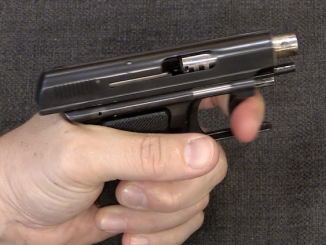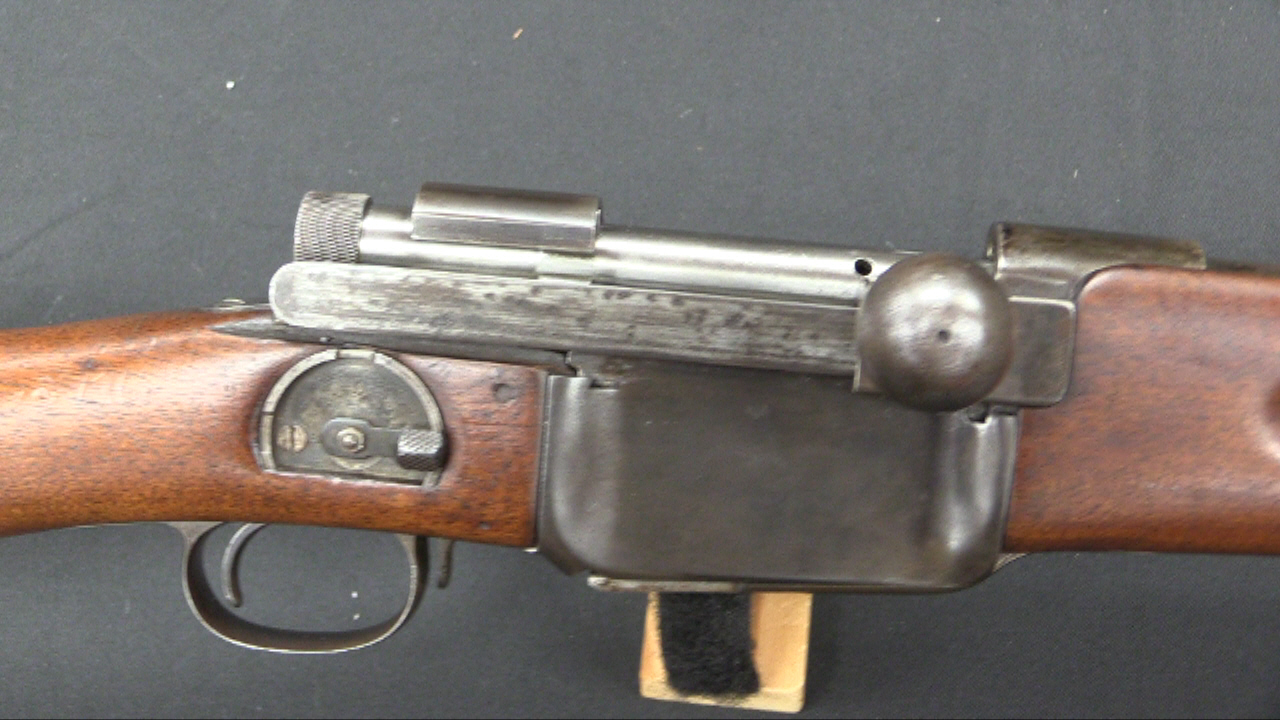The Swiss SIG factory was one of the earliest producers of semiautomatic military rifles, having produced the M1908 Mondragon rifles for Mexico. They continued to experiment with self-loading rifle designs, and in the mid 1920s came up with these two examples. They are extravagantly complex, and it is quite clear why they did not become production items – but they are fascinating to examine…
Related Articles

Semiauto Rifles
The Last Swiss Battle Rifle: SIG-Manurhin 542 (in .243)
After the failure of the SIG 530 rifle (a gas operated, roller locked design), SIG looked for a much simpler rifle design, in both operation and manufacture. Wheat they came up with was fundamentally AK-like, […]

Semiauto pistol
SIG Chylewski: One-Handed Vest Pocket Automatic
Designed by Witold Chylewski, this was only the second pistol manufactured by SIG (the first being the 6.5mm blow-forward 1894 MAnnlicher design). It was patented prior to WW1, but only after the war was Chylewski […]

Bolt Action Rifles
Mondragon 1894 Straight-Pull at RIA
Most people who recognize the name Mondragon know it from Manuel Mondragon’s model 1908 semiauto rifle, the first such rifle to be adopted on a large scale by a military (the Mexican Army, in this […]

Couldn’t come up with two different rifles with vastly different charging handles, made by the same firm!
Do I see clip ears, and do I also see a thumb notch in the left side of the receiver? If so, I’d say that reloading by a magazine swap was -not- intended, but rather reloading from above with 2 clips. That can be a fast reload when your mag only holds 10 rds anyway.
The fact that the 1925 model’s barrel rotates so freely makes me wonder if when reassembling it after takedown (say, after a paratroop drop in the dark), it might not be possible to reassemble it with the barrel “turned wrong”, i.e., so that when the bolt was in battery, its locking lugs weren’t engaging the recesses in the barrel extension.
If so, you could have a situation analogous to the infamous Ross rifle “bolt head 180 degrees out of position” malady, with the bolt in locked position, round in chamber, rifle ready to fire- but the bolt effectively unlocked.
With the solid backed-receiver and hammer-fired mechanism of this rifle, the situation probably wouldn’t be s life-threatening for the shooter as a Ross “bolt blowout”, but I’m sure it would be surprising to say the least.
A production version would no doubt have had a cam or other guide machined into that barrel extension to make very sure everything lined up properly when the rifle was being stuck back together. SiG doesn’t generally take chances with that sort of thing.
cheers
eon
Wouldn’t the rifle kick harder if that were true? And if so, wouldn’t it feed wrong as well had the gun been fired with a misaligned barrel? I’m probably wrong, but still, one can’t be too careful.
Most likely, you’d have a very hard kick as part of a nasty “pressure event”, with the case being yanked out of the chamber before pressure had dropped. Resulting in a burst case and a spray of hot gas and brass fragments, which with this receiver design would be mostly vented straight up and out to the side, rather like a Garand receiver in a case-head separation event.
As I said, surprising but not as likely to injure (or kill) the shooter as a Ross bolt blowout.
As for feeding the next round, I’d be very surprised if the bolt didn’t ride back over the hammer, slam into the rear wall of the receiver, and jam cockeyed in the boltway. I doubt the next round would be fed, period.
Also, consider that from Time Zero (first part of case extraction with pressure at peak), the first phase of the case failure would be near the head and probably vent a good bit of the gases downward- into the magazine. In addition to the upward and out to the right gas/fragmentation event, I’d expect a serious amount of gas vented down the inside of the front wall of the magazine, which would probably at least “bend” a few rounds’ bullets in the necks, and might very well blow the magazine floorplate right off.
In short, coming within a gnat’s whisker of blowing the rifle in two.
It could have ended up as the “Colt Revolving Rifle” of the 1920s, with all that implies.
cheers
eon
I think the lugs on the front of the trunnion are different enough so that it only goes into the receiver in the proper orientation.
Does the 1925’s muzzle end remind anyone else of a baby No.4 or is that just me?
The nosepiece is a dead ringer for that of the Swiss Model 1893/94 bolt-action cavalry carbine in 7.5 x 55. Unlike most of the Swiss rifles, instead of being a Schmidt-Rubin design, it was a Mannlicher-type straight-pull with a turning bolt-head operated by a cam-path machined into the inner bolt body.
IOW, a typical “phony” straight pull that was actually a turning bolt with a separate set of widgets to give a straight yank on the bolt instead of having to turn it up and pull it back in the conventional Mauser style.
About the only advantage such designs have over “conventional” turn-bolt systems is they are easier to convert to gas-operated self-loading action. No external “cam path” is needed to turn the bolt, because the outer or off-to-one-side cam assembly is already in situ.
Some of the very few “true” straight-pull bolt actions (i.e. ones with no turning action to the bolt at all) are the Mannlicher Model 1885, 1886 and 1888 Austrian military models (locking block under rear of bolt), the American Lee Navy Model 1895 6mm (Square-section bolt lifts up out of lockup as it travels backward), and most lever-action rifles (which have vertically-moving locking blocks or toggles- Winchester, Marlin, Savage, etc.).
The rest are just Mauser-type turning bolts with funny-looking cam paths in the bolt body. They add novelty but little in the way of practicality.
cheers
eon
Mannlicher rotary bolt head straight pull also had advantage that when combined with en-block clip it gave very RoF. IIRC figure I have guives 6 rounds for Mauser 98, 8 for Lee-Enfield and 11 fon Mannlicher 1895 in 15 seconds.
Kiraly is pronounced “kir-eye”, and Pal Kiraly translates as Paul King. Sounds a bit more slick in Hungarian perhaps.
There is probably a good story associated with the switch from gas to recoil operation, that with the benefit of hindsight we find that gas systems are dominant in rifles. While their is a certain elegance in the recoil system in that everything is closer to the bore axis, you still have a moving barrel. The first thought I had upon seeing the op-rod on the gas gun was that Garand rifles developed cracks at the dogleg and under went modification to remove a stress riser. The recoil gun looks more than capable of mounting a bayonet which is a problem encountered by the Johnson M1941, but at the expense of additional weight.
“gas to recoil operation, that with the benefit of hindsight we find that gas systems are dominant in rifles”
Notice that gas-operated fire-arm can be more easily adjusted to cartridges with smaller/bigger powder charge and in case of machine-gun rate-of-fire also can be adjusted with ease.
True, but recoil-operated actions tend to be easier to clean and less “environmentally sensitive” in the field.
The ability to handle varying powder charges is less important than advertised, really. Most military ammunition in a given cartridge type (0.303in, 7.9 x 57, etc.) is designed not to have too much variance in muzzle velocity, pressure curve, etc., as much as anything else to make manufacturing easier and to avoid having to modify the ladder sights on rifles, etc.
Most gas piston systems have adjustable ports like those on the Bren or FAL, not to allow for varying powder charges, but to adjust for greater gas pressure to maintain operation when the system is fouled with powder-residue. Direct-impingement systems often don’t have such adjustments, and so require very clean-burning propellants to operate at all, let alone under inclement conditions. (M-16, Ljungman AG-42, the Egyptian 7.9 x 57 and 7.62 x 39 knockoffs of the latter, etc.)
Generally, big gas pistons (large diameter) are better, as they can continue working longer between cleanings. (BAR, Bren, etc.)
But overall, for reliability under field conditions, especially in machine guns, recoil operation (as in Maxim/Vickers and Browning) tends to win.
The main reason so few rifles are recoil-operated is that to keep operating stresses and bolt velocity within reasonable bounds, you tend to end up with a heavier bolt system and thus more all-up weight. Unless you get inventive with your locking system, as H&K did with the roller-locked breech that SiG also used in their Stg 57 series rifles Ian covered here a while back. (Both of which were of course descended from the locking system of the MG-42.)
cheers
eon
Ah, the trade offs.
“few rifles are recoil-operated is that to keep operating stresses and bolt velocity within reasonable bounds, you tend to end up with a heavier bolt system”. I’m surprised that the “friction ring” from some shotguns hasn’t migrated to rifles, or maybe somebody tried?
“But overall, for reliability under field conditions, especially in machine guns, recoil operation (as in Maxim/Vickers and Browning) tends to win.”
Maxim machine gun was unquestionable commercial success, but as it was invented 1880s it has no worthy competitors for some time.
I assume that under “Browning” I should understand Browning M1919.
Notice that during WW1 American Forces used successfully gas-operated Marlin M1917 machine gun (tank machine gun) and Marlin M1918 machine gun (aerial machine gun), when French Army fielded Hotchkiss M1914 machine gun, which proved to be reliable enough for muddy trench warfare conditions, it also spawned some other weapons used across the world (Hotchkiss Portavive used by United Kingdom, Type 3 used by Japan), United Kingdom also fielded Lewis machine-gun.